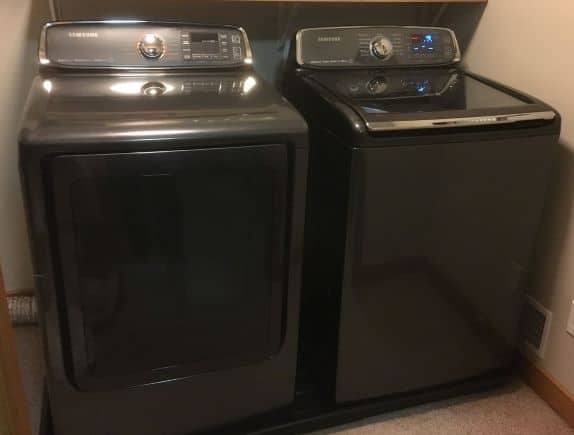Recently we decided it was time to replace our old clothes dryer. Our old dryer was gas, so we opted to stay with gas for the new dryer. Because we live in a rural area, and natural gas isn’t available, meant we had to convert the new dryer to propane (LP for short). It’s actually an easy DIY job. See what it took to complete our new Samsung dryer LP conversion.
The majority of gas appliances shipped to stores are normally set up for natural gas. That’s simply because the bulk of the population lives in areas that have natural gas. Converting your own appliance over to LP is not that difficult and can typically save you about $75. I will show you the steps I took to convert our Samsung gas dryer over to LP.
Video clip: Introduction to the Samsung dryer LP conversion and where to begin.
Table of Contents
Tools Required For The LP Conversion
How To Remove The Top And Front Panels On The Samsung Dryer
To begin open the front door and grasp the front edge of the top panel. Firmly pull up on the top panel and it will pop free. Lift the lid and prop it up with a block of wood.
There are a total of six screws that hold the front panel on. Three screws are under the front edge of the lid and three more are on the face of the front panel that is accessible with the door open.
Video: Front Cover Removal
This short video clip will step you through removing the front cover.
Front Panel Removed
Once the front cover is removed you can see the gas valve located at the lower right corner. To access the orifice and air shutter the gas tube assembly will need to be removed. A 10mm socket works well to remove the screw that holds the gas tube in place. With the screw removed the gas tube will slide off the orifice on the end closes to you. There is a slotted support on the far end of the gas tube, under the ignitor, that holds that end. Take care not to damage the ignitor on the end of the gas tube.
Video: Key Components
This short video clip will identify the key components to be replaced as part of the LP conversion and how to access them.
Gas Tube Removed
After the gas tube has been removed you will be able to clearly see the air shutter adjustment that will need to be made. Loosen the set screw and rotate the shutter clockwise so the “LP” is nearer to the set screw. Then retighten the set screw. This allows more air to mix with the propane for proper combustion.
Also, the orifice is now easily accessible with the gas tube removed. Use a ⅜” wrench to remove the natural gas orifice. This is also a good time to remove the vent cap.
Video: Gas Tube Removed.
This short video clip will show the important components and the changes needed.
Orifice/Vent Cover Removed
As it turned out the short screwdriver I had was still too long. However, I was able to loosen the vent cap with a pair of pliers. Once it was broke loose I was able to screw it out with my fingers.
In the below video y
Video clip: Orifice and vent cover removed.
Orifice/Vent Cover Installed
After making the air shutter adjustment screw the new orifice into the gas valve, reinstall the gas tube and secure it with the 10mm screw. Then screw the new vent cover into the gas valve and carefully snug it up. That actually completes the gas component part of the LP conversion.
Note: The conversion kit comes with stickers saying that the dryer has been converted to LP. Be sure to place the stickers near the gas valve assembly. This is to notify anyone working on it in the future that it has been converted LP.
Another thing I like to do is put the old natural gas orifice and vent cap back into the bag with the instructions and tape them to the inside bottom of the dryer. If you ever need to convert it back to natural gas, you’ll have everything you need.
Now all that’s left to do is put things back together in reverse order. Reinstall the front cover and snap the top back into place.
This video wraps up the Samsung Dryer LP conversion
This short video shows the gas valve components re-assembly and discusses some housekeeping items.
Closing Comments
This job took less than an hour and that included documenting my steps, so I could share it with you. Jobs like these can help build your confidence and make future DIY projects easier. One example is converting a natural gas range over to LP. I’ve done this a couple times and the steps are very similar. The only difference is each burner in a gas range has its own orifice.
The below short video clip shows the gas valve assembly I removed from our 35-year-old dryer. I did this to demonstrate that even though technology has advanced on the controls and electronics, many of the mechanical parts are relatively the same.
Our new Samsung gas dryer has many of the same belts, pulley, and rollers in it that its 35-year-old predecessor had. I see a few potential DIY repair projects for the future.
Video of 35 year old Whirlpool gas valve assembly
Disclaimer: This job is fairly straightforward, but if you are uncomfortable working with natural gas or propane, then, by all means, hire it done. There are several makes and models and the procedures and conversion kits may vary. Only take on projects you are comfortable with.
If you have any comments or questions, you can leave them in the comments section below or you can email us at [email protected]. FYI, we do not collect or share email addresses. We will only use them to reply to your comments or provide answers to your questions. We are also required to let you know that some of our links are “affiliate links”. This means if you click on a link and make a purchase, we could make a small commission, at no extra cost to you. This helps offset the cost of maintaining our website. So, if you like what you’ve seen, please be sure to give us a “Like” and “Share” on Facebook and Instagram too. Thank you for reading and good luck with all your home projects!


It’s very important that there are people with your skills, as some folks are not equipt or comfortable to take on a project like this.
Our expert technicians in the Chicago area are certified, highly-trained, and – most importantly – friendly guys that you won’t mind take care of your appliance. We are trained and certified for Oven repairs on any make or models
I would think the orifices are specific for each appliance (BTU ratings). As an example, our kitchen stove has 4 different sized burners and each one appeared to have different sized orifices. I would definitely recommend contacting the manufacturer for the correct size. If the orifice is too small it could underperform. If it’s too large, it could be a fire hazard. Please use extreme care.
Do you know if I can use an orfice out of my propane gas grill for the dryer? I’ve converted lp grills to nat. gas grills and have lp orifices somewhere in the shop, pretty sure they are the same as I would be ordering, I haven’t found anything about anyone doing it or mentioning it, not sure if you would know or maybe heard of someone doing that but figured I’d ask, thanks.
Let me start by saying I am not an appliance service technician. So I am not familiar with the screw inside of the gas valve. You may need to contact the manufacturer to get that information. I can tell you that you definitely need a regulator between the propane tank and any appliance. Typically right outside the house. Propane appliances operate on only about .4 psi, which is about 11″ of water column (wc). I would start there. Propane is very flammable/explosive, so I would not try operating the dryer again until a regulator is installed.
Trying to convert a Samsung gas dryer to LP for an older lady. Propane tank is pushing 120psi. I have swapped out the orifice and the other piece. If itor lights up, low pressure valve opens and flames ignites…… for about 30 seconds then it turns off. Can immediately push start and it does it all again. 2 questions…. Under the brass plug with the stem, there is a white plastic disc slotted for a foot screwdriver. What does that do and does it matter how far it is screwed in (daughter saw it and screwed it way down and I don’t know where it should be or if it matters). Second question is do I need to put a pressure regulator inline at the tank and If yes, what pressure? Her son installed 1/2″ black pipe (appx. 15 vertical feet from out side into the attic and then appx. 60 ft of black pipe thru the attic which then attaches appx. 25′ of gas flex line down into the laundry room. No regulator installed) that I know is dropping the pressure but the gauge at the tank, as said, is over 100lbs and If I recall correctly, the high flow valve on the dryer calls for . 5psi. Would excessive pressure cause the high limit switch to keep shutting off the dryer heater? She had originally hooked up a #20 tank, about half full, directly to the dryer after the LP conversion and it ran about 5 loads of laundry. Now that it is inside, with all that pipe/line and at much higher pressure, it won’t stay running. Thank you
I’m glad it helped!
Thanks very much for the information – even the manufacturer doesn’t provide this.
On the new dryers the top slides backwards after removing the rear screws – and the rest is as described here.
Excellent info.
Cheers.
Do not use it unless you are sure it came fitted with the orifice for propane! Propane has more BTU’s (British heating units) than natural gas and is therefore much more flammable than natural gas, so the propane orifice is smaller. If you use the larger natural gas orifice with propane, the flame will be much larger and hotter than it should be and could be a fire hazard. Verify with the store you purchased the dryer from what orifice came installed. They should be able to tell you.
We bought a Samsung gas dryer. We live in a rural area using propane. Can we hook up the dryer and use it without the propane conversion kit? What would or wouldnt happen? Thanks